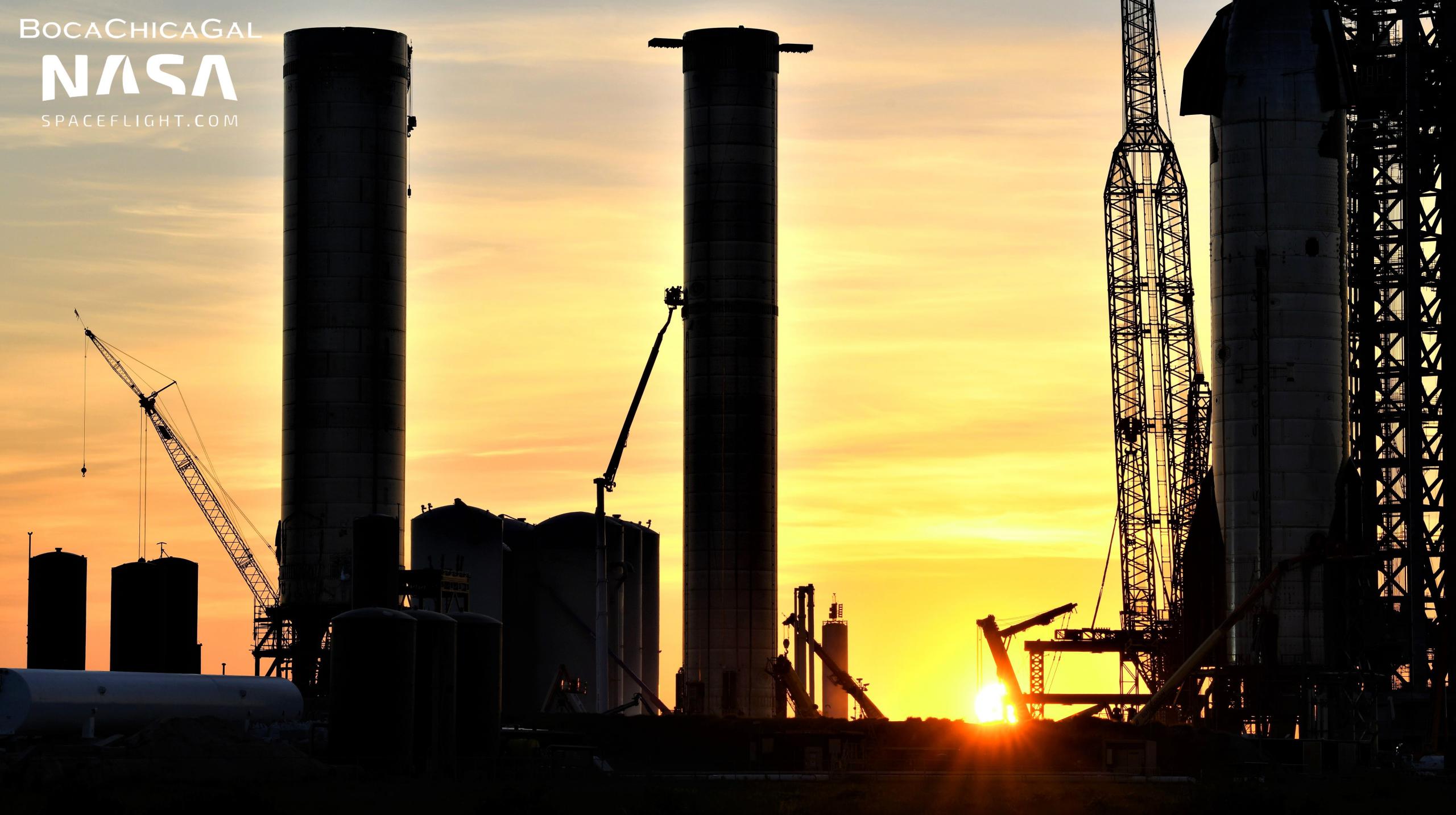
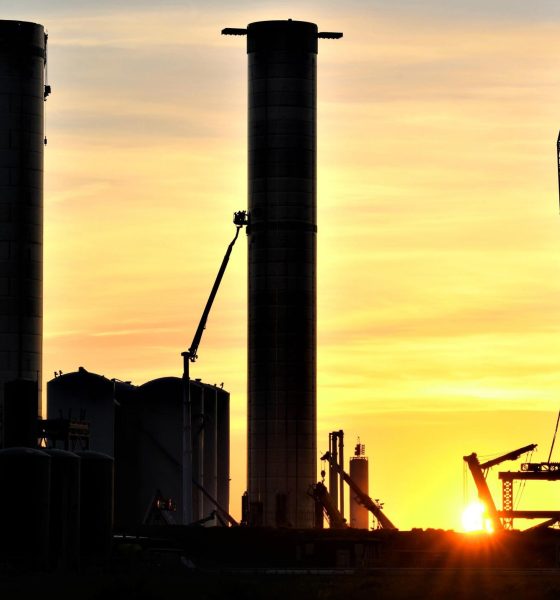
News
SpaceX preparing Super Heavy, Starbase for booster’s next steps
Amid a flurry of deliveries and work on several new Starship boosters, SpaceX is preparing the first truly finished Super Heavy for its next steps.
Partially completed by early September, Super Heavy Booster 4 (B4) supported SpaceX’s iconic ‘full stack’ fit test back on August 6th before returning to the build site but has mostly just floated around Starbase’s launch and test facilities in the seven weeks since its second trip to the pad. On September 10th, CEO Elon Musk himself suggested that SpaceX had plans to static fire the booster as early as mid-September – more than six weeks ago. Obviously, nothing even approximating Super Heavy testing transpired. Instead, at least relative to rapid-fire Starbase operations in the two years prior, SpaceX has almost absentmindedly worked on the booster, mostly completing partially-finished wire runs that run its full 69m (~225 ft) length.
In the last few weeks, though, the type of work being done on Super Heavy B4 has changed.
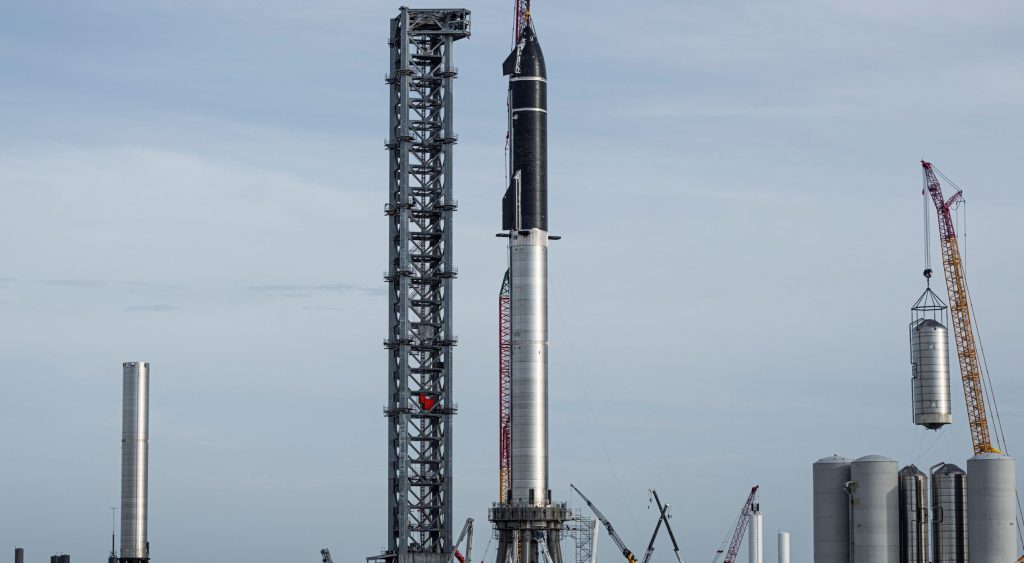
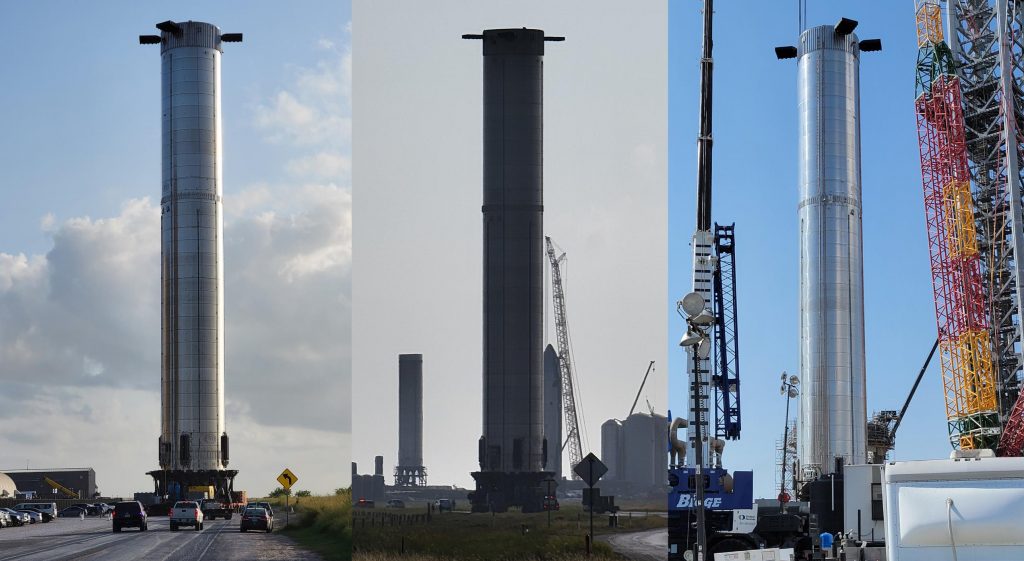
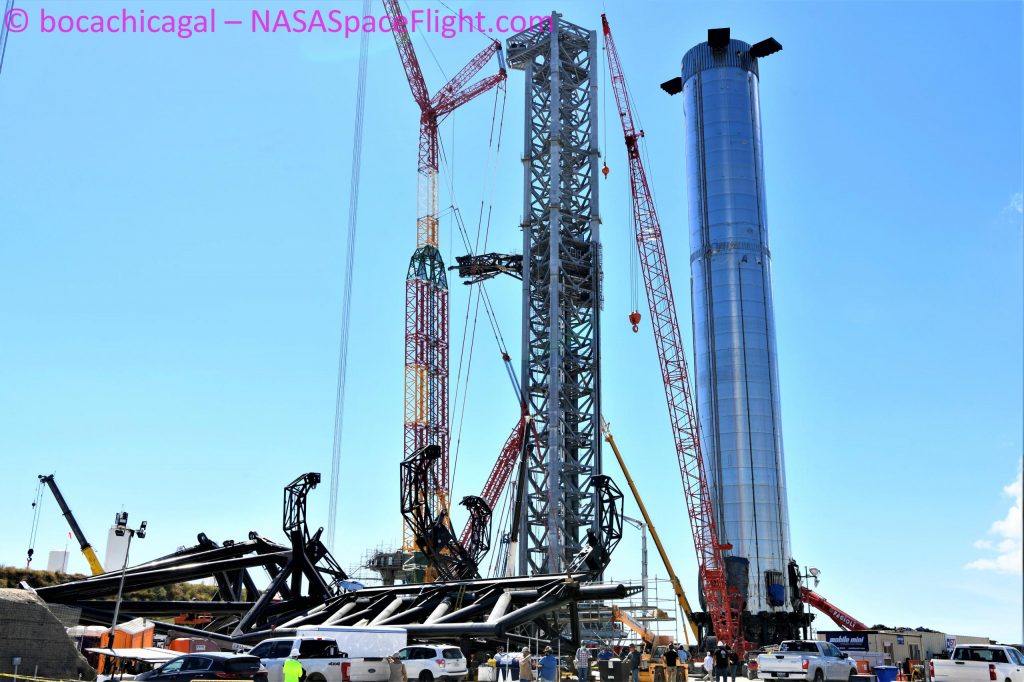
On September 26th, to give the Starbase construction crew more room to install giant arms on the orbital pad’s ‘launch tower,’ SpaceX removed Super Heavy B4 from the launch mount for the second time, temporarily relocating it to an unused patch of the pad’s old landing zone. Booster 4 hasn’t been moved since. However, while probably a bit slower than SpaceX would have liked, large-scale work on the Starship launch tower was effectively completed last week with the installation of two giant rocket-catching ‘Mechazilla’ arms.
A great deal of work has also been done on Starbase’s orbital tank farm over the last two months, including the installation of the last few storage tanks, the ‘sleeving’ of those tanks, a great deal of plumbing, and the start of real propellant deliveries. Save for a few days spent testing Starship S20 in late September and mid-October, the pad construction crews that have to evacuate the pad for 6-12 hours for every test have had three full months to work without interruption. Perhaps the most optimistic explanation for the unusually long gap between Booster 4 and Ship 20 rollout and testing is that SpaceX consciously chose to put off vehicle tests to avoid disrupting orbital launch site construction and retasked nearly all Starbase workers for that construction.
Regardless, with the launch tower and orbital tank farm now more or less structurally complete and work already underway to prepare the tank farm to support its first booster tests, most of the work that may have been drawing focus and resources away from ship and booster preparations appears to be wrapping up. That may be why, for the third time, SpaceX technicians began removing a number of Raptor engines from Super Heavy B4 around the start of October.
Aside from removing around a third to half of Super Heavy’s 29 Raptors, SpaceX also began slowly but surely installing parts of a steel heatshield designed to protect those engines during ground testing, ascent, and reentry. Newer Raptors have also been trickling from Starbase’s build site to the launch pad for installation on the booster and more engines will likely be (re)installed as heatshield installation progresses.

Perhaps the most unusual part of recent Super Heavy B4 work is the apparent application of some kind of foam around several racks of pressure vessels (COPVs), hydraulic manifolds, and umbilical connections installed around the booster’s base. Those racks will eventually be enclosed inside steel ‘aerocovers’ already staged beside Super Heavy. A number of Twitter users believe that the foam being selectively applied is for acoustic deadening – meant to protect sensitive electronics, valves, and computers from the brutal environment Super Heavy itself will produce at liftoff and during ground testing.
Ultimately, with Booster 4 work ramping back up and the zenith of orbital pad construction activity now likely behind SpaceX, preparations for major Super Heavy testing will hopefully resume. SpaceX has yet to perform a full Super Heavy wet dress rehearsal (WDR; fully filling a rocket’s tanks and performing a launch countdown) or fire up more than three Raptors on a booster or ship prototype. With any luck, that will finally change in the final months of 2021.

News
Tesla FSD Supervised wins MotorTrend’s Best Driver Assistance Award
The decision marks a notable reversal for the publication from prior years, with judges citing major real-world improvements that pushed Tesla’s latest FSD software ahead of every competing ADAS system.

Tesla’s Full Self-Driving (Supervised) system has been named the best driver-assistance technology on the market, earning top honors at the 2026 MotorTrend Best Tech Awards.
The decision marks a notable reversal for the publication from prior years, with judges citing major real-world improvements that pushed Tesla’s latest FSD software ahead of every competing ADAS system. And it wasn’t even close.
MotorTrend reverses course
MotorTrend awarded Tesla FSD (Supervised) its 2026 Best Tech Driver Assistance title after extensive testing of the latest v14 software. The publication acknowledged that it had previously criticized earlier versions of FSD for erratic behavior and near-miss incidents, ultimately favoring rivals such as GM’s Super Cruise in earlier evaluations.
According to MotorTrend, the newest iteration of FSD resolved many of those shortcomings. Testers said v14 showed far smoother behavior in complex urban scenarios, including unprotected left turns, traffic circles, emergency vehicles, and dense city streets. While the system still requires constant driver supervision, judges concluded that no other advanced driver-assistance system currently matches its breadth of capability.
Unlike rival systems that rely on combinations of cameras, radar, lidar, and mapped highways, Tesla’s FSD operates using a camera-only approach and is capable of driving on city streets, rural roads, and freeways. MotorTrend stated that pure utility, the ability to handle nearly all road types, ultimately separated FSD from competitors like Ford BlueCruise, GM Super Cruise, and BMW’s Highway Assistant.
High cost and high capability
MotorTrend also addressed FSD’s pricing, which remains significantly higher than rival systems. Tesla currently charges $8,000 for a one-time purchase or $99 per month for a subscription, compared with far lower upfront and subscription costs from other automakers. The publication noted that the premium is justified given FSD’s unmatched scope and continuous software evolution.
Safety remained a central focus of the evaluation. While testers reported collision-free operation over thousands of miles, they noted ongoing concerns around FSD’s configurable driving modes, including options that allow aggressive driving and speeds beyond posted limits. MotorTrend emphasized that, like all Level 2 systems, FSD still depends on a fully attentive human driver at all times.
Despite those caveats, the publication concluded that Tesla’s rapid software progress fundamentally reshaped the competitive landscape. For drivers seeking the most capable hands-on driver-assistance system available today, MotorTrend concluded Tesla FSD (Supervised) now stands alone at the top.
News
Elon Musk’s Grokipedia surges to 5.6M articles, almost 79% of English Wikipedia
The explosive growth marks a major milestone for the AI-powered online encyclopedia, which was launched by Elon Musk’s xAI just months ago.

Elon Musk’s Grokipedia has grown to an impressive 5,615,201 articles as of today, closing in on 79% of the English Wikipedia’s current total of 7,119,376 articles.
The explosive growth marks a major milestone for the AI-powered online encyclopedia, which was launched by Elon Musk’s xAI just months ago. Needless to say, it would only be a matter of time before Grokipedia exceeds English Wikipedia in sheer volume.
Grokipedia’s rapid growth
xAI’s vision for Grokipedia emphasizes neutrality, while Grok’s reasoning capabilities allow for fast drafting and fact-checking. When Elon Musk announced the initiative in late September 2025, he noted that Grokipedia would be an improvement to Wikipedia because it would be designed to avoid bias.
At the time, Musk noted that Grokipedia “is a necessary step towards the xAI goal of understanding the Universe.”
Grokipedia was launched in late October, and while xAI was careful to list it only as Version 0.1 at the time, the online encyclopedia immediately earned praise. Wikipedia co-founder Larry Sanger highlighted the project’s innovative approach, noting how it leverages AI to fill knowledge gaps and enable rapid updates. Netizens also observed how Grokipedia tends to present articles in a more objective manner compared to Wikipedia, which is edited by humans.
Elon Musk’s ambitious plans
With 5,615,201 total articles, Grokipedia has now grown to almost 79% of English Wikipedia’s article base. This is incredibly quick, though Grokipedia remains text-only for now. xAI, for its part, has now updated the online encyclopedia’s iteration to v0.2.
Elon Musk has shared bold ideas for Grokipedia, including sending a record of the entire knowledge base to space as part of xAI’s mission to preserve and expand human understanding. At some point, Musk stated that Grokipedia will be renamed to Encyclopedia Galactica, and it will be sent to the cosmos.
“When Grokipedia is good enough (long way to go), we will change the name to Encyclopedia Galactica. It will be an open source distillation of all knowledge, including audio, images and video. Join xAI to help build the sci-fi version of the Library of Alexandria!” Musk wrote, adding in a later post that “Copies will be etched in stone and sent to the Moon, Mars and beyond. This time, it will not be lost.”
News
Tesla Model 3 becomes Netherlands’ best-selling used EV in 2025
More than one in ten second-hand electric cars sold in the country last year was a Tesla Model 3.

The Tesla Model 3 became the most popular used electric car in the Netherlands in 2025, cementing its dominance well beyond the country’s new-car market.
After years at the top of Dutch EV sales charts, the Model 3 now leads the country’s second-hand EV market by a wide margin, as record used-car purchases pushed electric vehicles further into the mainstream.
Model 3 takes a commanding lead
The Netherlands recorded more than 2.1 million used car sales last year, the highest level on record. Of those, roughly 4.8%, or about 102,000 vehicles, were electric. Within that growing segment, the Tesla Model 3 stood far ahead of its competitors.
In 2025 alone, 11,338 used Model 3s changed hands, giving the car an 11.1% share of the country’s entire used EV market. That means more than one in ten second-hand electric cars sold in the country last year was a Tesla Model 3, Auto Week Netherlands reported. The scale of its lead is striking: the gap between the Model 3 and the second-place finisher, the Volkswagen ID3, is more than 6,700 vehicles.
Rivals trail as residual values shape rankings
The Volkswagen ID.3 ranked a distant second, with 4,595 used units sold and a 4.5% market share. Close behind was the Audi e-tron, which placed third with 4,236 registrations. As noted by Auto Week Netherlands, relatively low residual values likely boosted the e-tron’s appeal in the used market, despite its higher original price.
Other strong performers included the Kia Niro, the Tesla Model Y, and the Hyundai Kona, highlighting continued demand for compact and midsize electric vehicles with proven range and reliability. No other model, however, came close to matching the Model 3’s scale or market presence.








